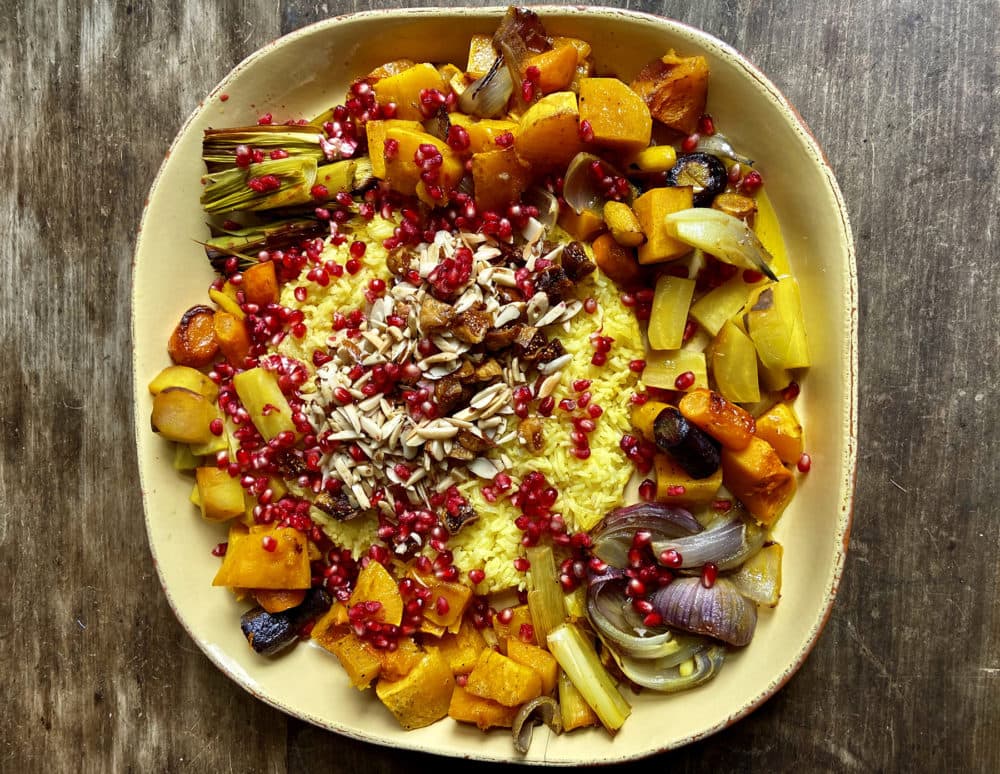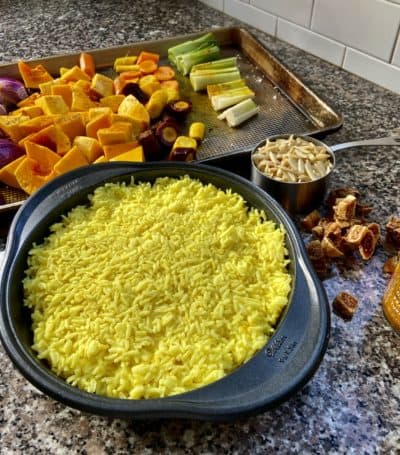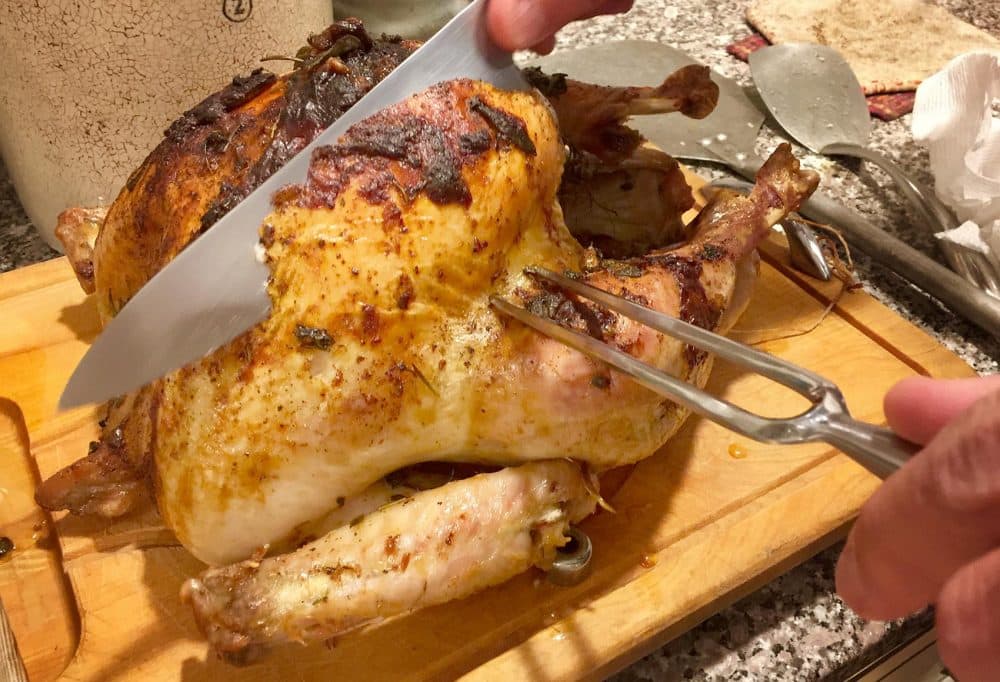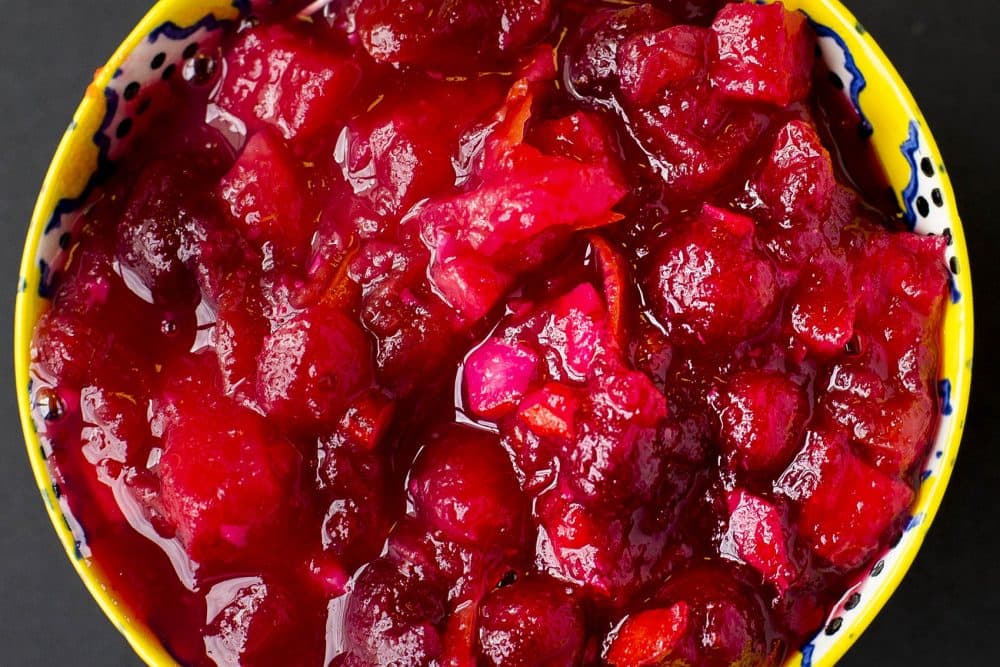Advertisement
Thanksgiving traditions — and a new vegan recipe — from chef Kathy Gunst

Thanksgiving is one of my favorite holidays. For someone who spends a good deal of time (well, in all honesty, almost all the time) thinking about cooking and food, I take great comfort in the idea that so many Americans are in their kitchens cooking some version of a Thanksgiving feast all at the same time. I love the idea that tables are getting bigger, with more family and friends able to safely gather again, giving even more to be grateful for.
This year I focus on two aspects of Thanksgiving: The first is a meal for vegans or for those who don’t eat turkey. This is a main course — or splendid side dish — of saffron-scented basmati rice topped with almonds, figs and pomegranates surrounded by roasted autumn vegetables.
I have also answered some questions about roasting a turkey. To brine or not to brine? How do I keep my turkey from drying out? When can I safely stuff the bird? These are some of the issues many of us are pondering this week of Thanksgiving. Relax — I’ve got some answers.
I’ve also written up my master turkey recipe and provided many tips for roasting a moist, flavorful turkey. And it’s not Thanksgiving without my annual cranberry-orange-ginger sauce. Have a wonderful holiday.
Vegan jeweled rice with roasted vegetables

Want a vegan dish to scream holidays without spending hours preparing? This is an ideal main course for vegans or a great side dish to add to your Thanksgiving table. Basmati rice is cooked with saffron and turmeric (which lends not only a beautiful earthy flavor but a yellow, slightly maroon color to the rice). The cooked rice is then placed in a cake pan and baked.
Meanwhile, an assortment of seasonal autumn vegetables — beets, winter squash, carrots, Brussel sprouts, leeks, etc. — are roasted. You can use any or all of the vegetables listed or add your own favorites like chunks of fennel, turnips, etc. The rice is unmolded from the cake pan and placed in the center of a serving plate, topped with almonds and dried figs sauteed in olive oil and then topped with fresh pomegranate seeds and juice. The dish is a celebration of color, flavor and texture.
Serves 4 to 6 as a main course and 8 as a side dish.
Ingredients
The rice:
- 1 ½ cups basmati rice
- ¼ teaspoon saffron
- ¼ teaspoon turmeric
- 3 cups water
- Pinch salt
The vegetables and topping:
- 2 medium-large red and or yellow beets
- 4 carrots, peeled and cut into 1 inch pieces
- 2 large leeks, dark green section discarded and pale green and white sections cut
- lengthwise, cleared, dried and cut into 1-inch pieces
- 1 ½ to 2-pound winter squash like butternut, buttercup or pumpkin, peeled and with seeds and pulp removed and cut into 1-inch pieces
- 2 cups Brussels sprouts, ends trimmed and left whole or cut in half if large
- 1 red or yellow onion, peeled and cut into large chunks
- ¼ cup plus 2 1/2 tablespoons olive oil
- ½ teaspoon ground cumin
- ½ teaspoon ground turmeric
- Salt and freshly ground black pepper
- 1 cup slivered or chopped almonds
- ½ cup dried figs, chopped
- 1 large pomegranate*
*To prepare the pomegranate, cut it in half and place the fruit side down over a bowl. Tap the skin with a rolling pin or wooden spoon to release the seeds. You may need to squeeze the fruit a bit to release them all. In a separate bowl squeeze the fruit to release all the juice; set aside. You can keep the pomegranate and juice covered and refrigerated overnight.
Advertisement
Instructions
- Make the rice: In a medium saucepan mix the rice, saffron, turmeric, salt and water and bring to a boil over high heat. Reduce the heat to low, stir and cover. Cook for 10 minutes, or until the water is just absorbed. You don’t want to overcook the rice since it will be baked as well. Remove from the heat and cool. The rice can be made several hours ahead of time.
- About an hour before serving: Preheat the oven to 425 degrees. Wrap the beets in foil. Roast the beets for 45 minutes to an hour or until tender when tested with a small sharp knife.
- Place the carrots, leeks, winter squash, Brussels sprouts and onion on one large or two small baking sheets or shallow roasting pans. Toss with the 1/4 cup olive oil, salt and pepper, cumin and turmeric. Roast on the middle shelf for about 30 minutes (put the vegetables into the oven after the beets have roasted for about 30 minutes) or until tender when tested with a small sharp knife.
- Meanwhile, place 1 tablespoon of the oil onto the bottom and sides of a 9 1/2-inch round cake pan. Press the cooked rice into the pan and bake on the middle shelf for about 15 minutes. The rice should go in after the vegetables have roasted for 15 minutes.
- Remove the beets and let cool for 5 minutes. Carefully unwrap and remove the skin from the beets using your fingers or a small sharp knife. Cut the beets into 1-inch pieces and add to the baking sheet with the roasted vegetables.
- While everything is roasting, heat the remaining 1 1/2 tablespoons olive oil in a medium skillet over moderate heat. Add the almonds and cook, stirring, for 2 minutes. Add the figs and salt and pepper and cook, stirring, for another 2 to 3 minutes.
- Carefully unmold the rice in the center of a large serving platter. Surround with the roasted vegetables. Pour the almonds and figs on top of the rice. Sprinkle the pomegranate seeds on top of the rice and vegetables and spoon the pomegranate juice over everything. Serve hot or at room temperature.
Turkey tips:

- Think of a turkey as roasting a large chicken. It’s not that complicated. First step: Stop worrying.
- Thawing tips: When working with a frozen turkey, you’ll need to plan to leave several days to defrost the bird. This takes planning. The best way to defrost a frozen bird is in the refrigerator, but it can take up to three to four days to defrost a bird using this method.
- According to the U.S. Department of Agriculture: "Place the frozen turkey in the fridge — be sure your refrigerator temperature is set at 40 degrees Fahrenheit or below. You'll need to allow about 24 hours for each 4 to 5 pounds of frozen turkey you plan to thaw in the fridge."
- If you haven’t left enough time, there are several tricks:1. Fill a sink (or if it’s a really big bird you can use the bathtub — I’m not kidding!) with cold water and submerge the frozen bird in the sink. Flip the bird over after an hour or so. You need to make sure the bird is totally submerged in the water so you might want to put a can of soup or a heavy pan on top to keep it underwater. This keeps the bird safe and chilled. Be sure to change the water every hour to keep it very cold. Defrosting a frozen bird in a sink of water will take about one hour per every two pounds. If you have a 10-pound turkey it will take five hours; 20-pound frozen bird, you’ll need 10 hours. Plan your time accordingly.2. If you still don’t have enough time, you can always roast the bird while it’s still slightly (but not totally) frozen, but you’ll need to reduce the oven temperature and roast for almost double the amount of time called for. You’ll be cooking it longer and slower allowing for defrosting time. Find more tips on the USDA website.
- To brine or not to brine: Many cooks swear by brining a turkey. Brining is the process of letting the bird sit overnight in a salt solution, with the hopes of keeping it moister and plumping it up. I say it’s really not necessary. Thanksgiving is already complicated enough. You have enough to do without worrying about soaking the turkey in a brine solution overnight.
- How do you keep the turkey moist without brining? I saute lots of garlic and herbs in either olive oil and/or butter. This is what I use to baste the bird and keep it moist throughout the cooking. The fat keeps the bird moist and the garlic and herbs flavor the skin and the meat.
- Never stuff a bird more than 30 minutes ahead of time. You risk bacteria forming if the stuffing sits around inside the bird. Stuffing the bird should be one of the last steps before it goes into the oven.
Master recipe for roast turkey with garlic and herbs and a pan dripping gravy
This recipe is for an 18 to 20-pound bird but can easily work with a smaller one by reducing the cooking time. If you're working with a frozen turkey, be sure to defrost it in time (see frozen tips above).
Ingredients
Turkey:
- One 18- to 20-pound fresh turkey (preferably organic), at room temperature*
- 1 1/2 tablespoons vegetable or olive oil
- Salt and freshly ground black pepper, to taste
- 1 stick butter
- 10 cloves garlic, peeled and left whole
- 2 1/2 tablespoons chopped fresh thyme
- 2 1/2 tablespoons chopped fresh sage
- Sweet Hungarian paprika
- Your favorite stuffing, optional
- 1 slice bread, optional
- Kitchen string or butcher’s twine
*Room temperature simply means that the bird shouldn’t come straight out of the refrigerator. You don’t want to let it sit around for hours; remove from the refrigerator about one hour before roasting while you make the stuffing. And never stuff a bird until you’re just about to put it in the oven.
Stock and gravy:
- 1 turkey neck, heart and gizzard from the inside of the turkey
- 1/2 cup coarsely chopped fresh parsley
- 2 onions, peeled and quartered
- 2 ribs celery, chopped
- 2 carrots, peeled and chopped
- 6 peppercorns
- 1 bay leaf
- Salt and freshly ground black pepper, to taste
- About 2 1/2 tablespoons flour
Instructions
- Defrost the turkey if frozen.
- Preheat the oven to 450 degrees. Arrange the oven rack so the bird will fit on the middle shelf without touching the top shelf.
- Clean the bird and remove the neck, giblets, liver and heart, and set aside for the stock/gravy. Pat the bird dry with paper towels. (The liver can be reserved; it is delicious lightly coated in flour and then sautéed in a hot skillet greased with 1 teaspoon of butter for about five to six minutes per side.)
- Use the oil to lightly grease the bottom of a large roasting pan. Season the turkey with pepper and salt (only if you did not brine the bird) inside the cavity and outside the skin. If stuffing the bird, loosely stuff both the body and neck cavities of the turkey with your choice of stuffing, pressing down but being careful not to overstuff the bird. Use the whole slice of bread as a "door" to keep the stuffing inside the large body cavity; simply press the bread into the cavity as a way of keeping the stuffing inside so it won’t fall out while roasting. Carefully place the bird into the roasting pan, breast side up. If you want to use a roasting rack simply place the bird on the rack and set inside the pan.
- In a medium skillet, heat the butter over low heat. Add the garlic cloves, thyme and sage and let cook for two to three minutes until the butter has completely melted, and the garlic is just beginning to turn a light golden brown. Remove from the heat. Using a spoon or a barbecue or pastry brush, brush the entire skin of the turkey with some of the garlic butter and scatter at least half the garlic cloves around and on top of the bird. Keep the remaining garlic and butter for later basting. Sprinkle the top of the bird with the paprika, salt and pepper. Using a piece of kitchen string, tie the legs together to keep them from touching the sides of the roasting pan; tying the legs also makes for a "neater" looking roasted turkey.
- Place the bird on the middle shelf of the oven and roast for 30 minutes. Reduce the heat to 350 degrees and loosely cover the bird with foil. Roast the turkey another 3 1/2 to 4 1/2 hours, about 15 to 20 minutes per pound, depending on the freshness of the bird. (Fresh turkey tends to cook much faster than those that have been frozen. And unstuffed birds will cook even faster so be sure to check the turkey after it’s roasted for 10 minutes per pound.) Baste the bird every hour or so with the remaining garlic and butter and baste with the liquids that have accumulated on the bottom of the roasting pan. Remove the foil for the last hour of roasting time to give the bird a golden brown glaze.
- While the bird is roasting, begin the gravy by making the turkey stock: Place the reserved neck, giblets, and heart in a medium saucepan. Add the parsley, onions, celery, carrots, peppercorns, bay leaf, salt and pepper to the pot and cover with about 8 cups cold water. Bring to a boil over high heat, reduce the heat, and let simmer on very low heat for about one to two hours. This will produce a light turkey stock that will be the basis of your gravy. Taste for seasoning and remove from the heat.
- To test to see if the turkey is done: The bird should be a gorgeous golden brown; when you wiggle a drumstick, it should feel slightly loose, and when you pierce the skin directly above the wing, the juice should run clear yellow, and not pink. A meat thermometer placed deep into the breast should read 150 degrees. The bird will keep cooking once it’s removed from the oven so be careful not to overcook it. Gently remove the bird from the roasting pan and place on a serving platter; cover loosely with aluminum foil.
- To finish the gravy, once you’ve removed the bird, place the roasting pan over two burners over moderate heat. (If there seems to be an excessive amount of turkey fat in the bottom of the pan, remove it by tilting the juices to the side and remove with a spoon or baster, being careful not to remove any of the natural juices.) Use a spatula to loosen any bits clinging to the bottom of the roasting pan. Sprinkle on the flour and, using a whisk, mix the flour with the juices in the bottom of the pan. Let cook for one minute, stirring, until the paste has come together and is beginning to turn a pale golden color. Pour a little more than half the turkey stock through a sieve into the pan and whisk to create a smooth gravy. Let simmer for about five to 10 minutes, until slightly thickened and flavorful. Thin the gravy by adding additional stock as needed. Simmer until the gravy is the desired thickness. Season to taste with salt and pepper. Keep the gravy warm over a low heat, stirring occasionally, until ready to serve.
Cranberry sauce with orange, ginger, pineapple and pecans

Every year I tweak my holiday cranberry sauce just a bit, but this combination (tart berries with sweet oranges, ginger, pineapple chunks and meaty pecans) is a real favorite. Serve with holiday birds, on sandwiches, with a cheese platter, or serve it as a dessert sauce for butter cookies, pound cake or pies.
Makes about 6 cups.
Ingredients
- 1 cup sugar
- 2 cups water
- 1/4 cup maple syrup
- 1 pound fresh cranberries (if frozen do not thaw)
- 1/4 cups fresh orange juice*
- 1/4 cup very thinly sliced orange rind*
- 1 tablespoon grated orange zest*
- 1 to 1 1/2 tablespoons finely chopped fresh ginger (I like a pronounced ginger flavor so I use 1 1/2 tablespoons)
- 1 tablespoon coarsely chopped candied (or crystallized) ginger, optional
- 1 1/2 cups fresh pineapple, cut into ½ inch size pieces
- 1 cup pecans, or your favorite nut, coarsely chopped**
*You’ll need about 2 to 3 large oranges. First, use one orange to remove the zest (the outer peel without the bitter white pith) by slicing it off with a small, sharp knife or a wide vegetable peeler. Use another orange for the grated rind and then squeeze both oranges for their juice.
**Toast the nuts in a 350-degree oven on a baking sheet for about 6 to 8 minutes or until aromatic.
Instructions
- Place the sugar and water in a large saucepan and bring to a boil over high heat. Reduce the heat to low and cook for about 10 to 15 minutes, or until the sugar syrup begins to thicken slightly and turn a pale amber color. Add the maple syrup and the cranberries and cook, stirring occasionally, until the cranberries begin to pop. Add the orange juice, orange rind and orange zest and cook for another 5 to 10 minutes, or until the sauce begins to thicken slightly. Add the fresh and crystallized ginger and cook for 2 minutes. The sauce should be full of flavor and slightly thickened. (If the sauce still seems thin — remember it will thicken as it chills — remove the cranberries and flavorings with a slotted spoon and place in a bowl. Boil the liquid in the pot over a moderate-high heat until it is thickened slightly, about 5 to 10 additional minutes, if needed. Place the cranberries back in the slightly thickened sauce.)
- Remove the sauce from the heat and stir in the nuts and the pineapple. Let cool completely. Place in a clean glass jar and cover. Refrigerate for up to ten days, or freeze for six months.Other Thanksgiving Favorites from Past Years:
Turkey, tips and sides:
- Thanksgiving 101
- Tips for leftovers
- Ideas for a smaller — but still festive — Thanksgiving
This segment aired on November 22, 2021.

